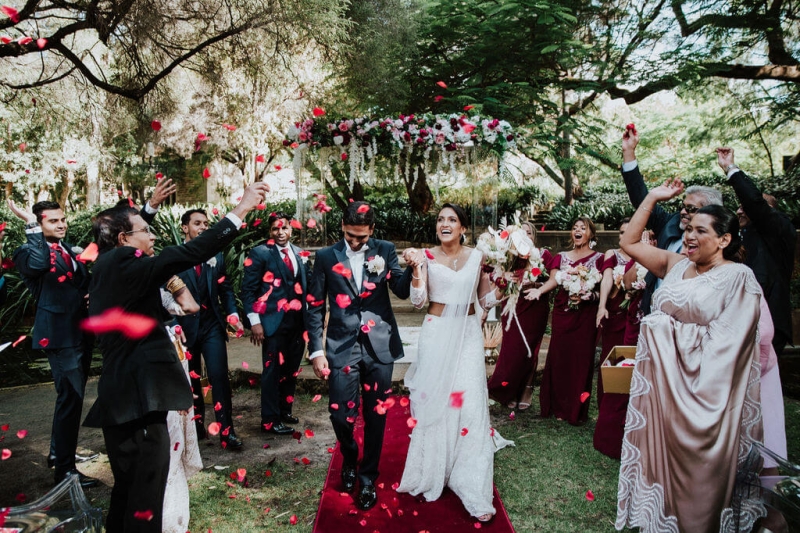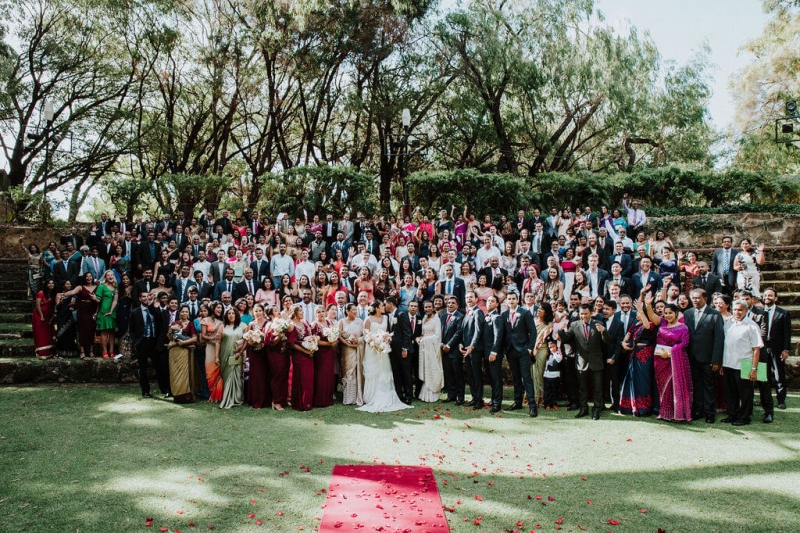When you become a marriage celebrant, you quickly get thrust into this heady world of tradition and ritual and you get to marvel at some truly amazing moments. True… some of it can seem a little antiquated and, more often than not, people seek to include these traditions in their ceremony but can have absolutely no idea what they mean or why they even want it. So I’ve (Dilhari from Kiss Me You Fool) created “How To Have A Sri Lankan Poruwa Ceremony & Other Cultural Traditions” to give you some insight into cultural elements you can add to your wedding ceremony.
Header Image & Image: Magnum Chin
Speaking personally, when a couple asks me to include a cultural tradition, I research the heck out of it. I want to know everything about it so that when I get to speak to it during a ceremony, I am the most informed I can possibly be. I know why we are doing it, I know how to get my linguistics on if needed and I know what it means to my couple and/or their families. That’s all part of being part of my couples’ story; immersion in my couple and their history.
A moment that was particularly poignant for me was back in February 2021. There I was about to officiate at my first Sri Lankan wedding. Now, I have watched a fair few of these over the years being a proud Sri Lankan Australian woman. Generally, I’d be the younger person trying not to fall asleep; being completely oblivious and naïve to the cultural significance around me. But this was different. This was adult me. Adult me who was about to perform a wedding in front of approximately 200 people who used to call the same tiny island home and I knew nothing about what this ceremony entailed. So, I read and I read, and I asked question after question. Ultimate preparation though came in the form of the bride’s mother who was so detailed and determined to ensure I knew the structure like the back of my hand. She provided me with the most excellent cheat sheet.
Image: Magnum Chin
In a very abbreviated nutshell, a Sri Lankan wedding ceremony centres around a ritual called a Poruwa ceremony which has Buddhist influences. It’s involved but to keep it concise this is what this particular couples’ moment called for:
(For clarity, I shall refer to the couple as B & S)
1.
The poruwa is the decorated platform that the ceremony takes place on which represents the house that the couple will share and is symbolic for their marriage and their new life.
2.
The couple is guided onto the Poruwa by their fathers (or elder uncle).
Image: Magnum Chin
3.
The couple is offered betel leaves as an offering to the gods which are then dropped onto the Poruwa seven times to honour seven generations of relatives on either side.
Image: Magnum Chin
4.
The couple exchange rings followed by B gifting a necklace to S to symbolise a promise to protect and care for them.
5.
S’s uncle tied the pinky fingers of the couple with a blessed thread (pirith nool) to symbolise their union of marriage.
6.
S’s father poured water over the bound fingers – water and earth being eternal; the water poured and the earth on which it falls is the lasting witnesses to the marriage.
Image: Magnum Chin
7.
S’s mother offered kirribath (literal translation = milk rice) to the couple and the B’s mother offered a glass of milk as a symbol of prosperity – these elements signify that the couple starts their new life together with the blessings of their mothers.
8.
S’s friends sang a traditional Buddhist chant (the Jayamangala Gatha) that depicts stories of wisdom and compassion as a blessing to the couple.
Image: Magnum Chin
9.
The fathers lead the couple down from the Porwua.
Image: Magnum Chin
10.
The couple then lit the traditional Sri Lankan oil lamp; light being a symbol of wisdom and to signify the start of a bright new future together.
Images: Red Electric
The Poruwa ceremony was performed by a Sri Lankan elder and each step had particular Sinhalese wording that was required. However, my couple was nothing if not pragmatic about these beautiful rituals being understood by all their guests, not just those that spoke the language fluently.
So, as each step was taken, I would translate in English thereby ensuring that everyone present could follow along; and THEN I dazzled them with a civil ceremony afterwards. I remember having some gregarious guests come up to me and express how much they had appreciated having had the opportunity to be part of the moment and actually immerse themselves in it rather than just blindly observing. That stayed with me. It has also ensured that for all the Sri Lankan ceremonies I have had the privilege of officiating at since I have suggested to the families that this approach is the one we adopt rather than simply having the poruwa ceremony in Sinhalese.
Image: Magnum Chin
You see, tradition is something that binds families; that celebrates the culture and can be bigger than the sum of its parts but if possible, it is not something that has the effect of alienating guests who are not of that culture or have never experienced those backgrounds.
It also made me realise that not every couple is going to want the full shebang so to speak. Some couples want that nod to their heritage but want an abbreviated version and that is also, absolutely achievable. There has been the lightning of the Sri Lankan oil lamp following a surprise hitching, there has been the condensed Chinese tea ceremony after the official paperwork was signed, there has been the Welcome to Country and the smoke ceremony conducted by a First Nations elder before the big walk up the aisle, there has been the shouting of “mazal tov” when a Jewish bride stomped on glass just before the big kiss.
Some Cultural Traditions You May Want to Include In Your Ceremony As A Nod To Your Heritage:
- Jump the Broom (African American)
- Exchange Stefania three times during “The Crowning” (Greek)
- Take seven steps around the agni (holy fire) and recite the pledge of marriage (Hindu)
- Become part of the family and pin some tartan (Scottish)
- Be bound together in a handfasting ceremony (Pagan)
- March to the beat of all the drums in zaffe (wedding march) from one location to the ceremony venue (Lebanese)
- Carry around a piece of iron in your pocket to ensure good fortune and ward off all the bad juju (Italian)
- Forgo vows and sip saki thrice from three different cups as part of the san san ku do (Japanese)
- Conclude the ceremony with a whakatauki (proverb) to bless your future, your marriage and acknowledge the land (Maori)
The ways you can incorporate your background or the background of your loved ones; the opportunity to show respect and/or that continuity of beliefs is limitless. All it takes is a little additional planning, some careful translation, and a determination to ensure everyone present feels included.
So, when your celebrant asks you if you want to include any cultural elements, don’t just brush it off and put it in the too-hard basket – talk to your officiant, brainstorm how to elevate your moment from the stock standard to the FABULOUSLY YOU, all while honouring your history.
Image: Magnum Chin
About Kiss Me You Fool: Dilhari is the pint-sized #pocketrocket celebrant behind Kiss Me You Fool and has been hitching loved-up couples for 10 years now. Whilst she may not have been able to pursue her dream of singing on Broadway (#hamfan right here), she has ABSOLUTELY relished the gift of levelling up ceremonies to be all kinds of epic. Over the years she has continued to actively champion the importance of wedding ceremonies which resulted in co-creating (with her fabulous work husband Kirk Goodsell) the wedding ceremony showcase, Ceremony Feels which made its debut in 2019 and is a way of encouraging couples to prioritise their wedding ceremony as part of their wedding day. She can often be spotted attempting to navigate the fine art of multitasking between celebrant life, lawyer life, wife life, and mum life and even though all facets keep her tremendously busy, she knows no other way. The way to her heart is undoubtedly through laughter, RnB music, cake of any kind, and of course, drooling over all the many many delectable shoes she aches to give a loving home.























Join the conversation